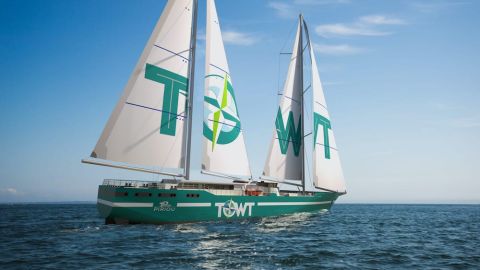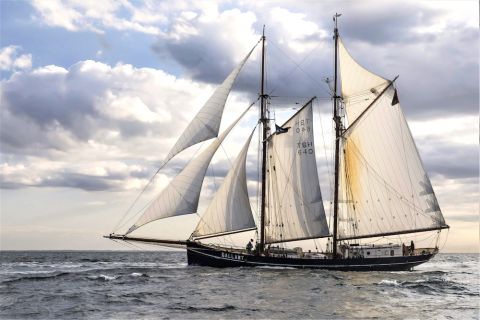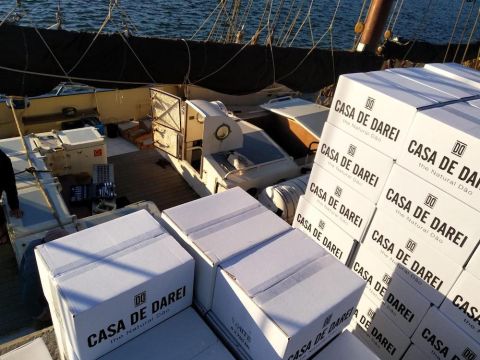10 April 2024 With the wine industry searching for ways to reduce the climate impact of its global transportation network, Louise Hurren looks at how wind is being used to help decarbonise wine.
I stood shivering and crestfallen on a blustery, grey morning in London’s St Katharine Docks. It was 2008 and I was working for a French wine brand associated with the Compagnie de Transport Maritime à la Voile (CTMV) and their Fair Wind Wine venture.
Languedoc wines were being shipped from France to the UK on a 108-year-old, triple-masted wooden sailing schooner. Journalists were waiting to taste the wines on the boat, but adverse weather conditions meant the 108-year-old Kathleen & May had not arrived, which effectively took the wind out of our collective sails (pun intended).
It also illustrated one of the drawbacks of wind-powered marine transport, namely its unpredictability. The stately 50-metre ship did eventually reach the shore and the wines were duly tasted and rated, so all was not lost.
The Kathleen & May made four crossings between France and Ireland, England and Canada but it was not smooth sailing for CMTV, who subsequently went into liquidation, aided and abetted by the global economic crisis.
Calculating carbon footprint
Determining the carbon footprint of a bottle of wine is not a simple task, but transportation is where wine leaves the largest mark. The worst emissions are from air cargo, followed by road transport (137 g of greenhouse gases per tonne of cargo per km, or roughly six times that of rail and 20 times that of sea transport1). Maritime transport is one of the most energy-efficient modes of transport, but it is also a large and growing source of greenhouse gas (GHG) emissions. Indeed, in July 2023 the International Maritime Organisation (IMO) took a step towards reducing GHG emissions from international shipping, committing to new targets for emission reductions and to developing and adopting measures in 2025 to deliver on these targets. At EU level, sea transport represents 3–4% of the EU’s total CO2 emissions (over 124 million tonnes of CO2 in 2021)2 while accounting for 4% of global GHG emissions and 10% of global sulphur emissions. In 2018, global shipping emissions represented 1,076 million tonnes of CO2, and projections show that these emissions could increase by up to 130% of 2008 emissions by 2050. If the climate change impact of shipping activities grows as projected, it will undermine the objectives of the Paris Agreement (a global framework to avoid dangerous climate change by limiting global warming to below 2 °C and pursuing efforts to limit it to 1.5 °C).
In the face of these facts, it seems obvious that using wind as a cleaner means of sea transport should be encouraged. Shipping by sail has a romantic image and a whiff of nostalgia, but also some solid sustainability arguments. ‘Wind is a viable solution that is free, largely predictable, and completely renewable. Wind alone cannot be the only solution, but it most definitely has its place’, says Stefan Gallard, chief marketing officer for Grain de Sail, a French company based in St-Malo making waves in the quest to help decarbonise wine (their second sail-powered cargo vessel, Grain de Sail II, completed its first transatlantic crossing in spring 2024). ‘With our ship designs we can reduce the carbon footprint of shipping by over 90% compared to an equivalent trip on a conventional cargo ship. There are other issues like SOx and NOx [sulphur oxides and nitrogen oxides, the two main pollutants from ship emissions, which cause acid rain and air pollution] and impacts on marine life that can be solved with our approach’, he comments.
Surfing the wind-power wave
Since Fair Wind Wine’s demise in 2008, other companies have sailed forth in its wake.
France’s TransOceanic Wind Transport (TOWT) started shipping wine by wind in 2013, chartering a traditional cargo sailing boat to bring bottles from northern France to London for the Raw Wine Fair. The Brittany-based company has transported cargo including wine, cognac, rum, champagne, cider and beer in this way for a decade, but now they are upping their game. Construction is under way of the first in a series of modern cargo ships with wind as the main propulsion system, which the company claims will ‘radically decarbonise CO2 emissions of maritime shipping’.
Anemos is an 80-metre, side-loading pallet-carrier with a capacity of 1,000 tonnes, and her launch is scheduled for June 2024 from Le Havre. Around 85% of her maiden voyage’s cargo will be Martell cognacs, and Mumm and Perrier Jouët champagnes. Some 400,000 bottles will be delivered to New York (and from there, to Pernod Ricard USA’s distribution warehouse nearby).
Meanwhile, another, larger-scale French sail-freight project is in the pipeline: Neoline is a crowdfunded venture that aims to offer new transport services via innovative vessels equipped with sails for their main propulsion system. The first Neoliner is a 136-metre, four-masted cargo sailing ship (see main image at the top of this article). Blue-chip names, including Renault, Clarins, Hennessy Cognac and Rémy Cointreau, have already signed up to fill the hold, and monthly transatlantic shipments from western France to Halifax, Canada and Baltimore, US, are scheduled to start in 2025.
Low-tech, low-carbon options
In Bristol, UK, Port O’ Bristol has been operating since 2018. ‘We’re the low-tech, DIY version of wine-by-sail transportation, moving wine generally made by smaller scale, high-quality producers with whom we’re a more natural fit’, says founder Anton Mann. He charters a 36-metre Dutch cargo schooner named the Gallant to deliver an estimated 18,000–27,000 bottles of wine from Porto to Bristol each year in two or three crossings, each taking roughly ten days and saving an estimated 1.6 tonnes of CO2 per trip, compared with transportation by road. The Gallant belongs to France’s Blue Schooner Company (BSC). It was built in 1916 as a fishing vessel but was converted to carry cargo and now boasts solar panels and a large battery bank to meet the power requirements for lighting and crew needs on board (eg sink and shower water pumps), as well as the navigation and communication equipment.
Being 100% wind-powered has its issues. ‘We can be becalmed for a few days, and if there are storms or huge swells, we have to avoid the worst and sometimes make a detour, or even find a safe haven to let the weather pass. Our schedules are based on very low average speeds to allow for poor sea conditions, but we’re completely reliant on the weather so it’s impossible to guarantee loading or unloading dates’, says BSC’s co-founder Guillaume Roche. Roche is realistic – ‘we all know that wind-propelled vessels will not replace container ships in the short term’ – but he highlights some impressive figures: using a sailing vessel to transport one tonne of cargo on a transatlantic crossing emits just 14 g of CO2/tonne, compared with 6,200 g of CO2/tonne on a standard diesel-fuel-powered container ship.3
The Gallant’s cargo capacity, however, is only 35 tonnes and demand for her services currently outstrips supply, so BSC plans to commission a more efficient, 200-tonne vessel to open new routes for their clients. ‘With the new boat we’ll be able to take European wines and spirits to North America’s east coast before heading south to the Caribbean and Colombia’, says Roche.
Wine for sail
Grain de Sail started designing their first, 24-metre wind-powered cargo boat, called Grain de Sail I, in 2012. In late 2019 she made her maiden voyage, taking French organic wines to New York before carrying donated medical supplies to the Caribbean for a charity project. There the boat was reloaded with cacao mass and green coffee destined for France, where they were processed and sold as Grain de Sail-branded chocolate and coffee. The three-month voyage consumed an estimated 150 litres of diesel fuel, a marked contrast with the 200+ tonnes of fuel needed daily by traditional cargo ships. The project garnered support from natural-wine champions Pascaline Lepeltier and Alice Feiring and the wines have been sold through wine shops, restaurants and bars across New York State.
With six transatlantic loops completed and some 75,000 bottles delivered for clients including Charles Heidsieck, Hine and Languedoc sustainability pioneer Château Maris, the company has just expanded its service in spring 2024 with the launch of Grain de Sail II. A 50-metre custom-designed cargo sailing boat with a cargo capacity of 350 tonnes (180,000 bottles) – 10 times that of her predecessor – her size and build means she can navigate the Atlantic during hurricane season, making six crossings a year viable. Conventional container ships are faster (the crossing can be completed in 12–15 days) but loading in a major French port and customs clearance on arrival in the US takes that much longer. By using smaller, less busy secondary ports, Grain de Sail II can make up time.
Crests and troughs
Grain de Sail II’s maiden voyage began in St-Malo, France, on 15 March 2024 with an estimated crossing time to Elizabeth, New Jersey, of 18 days. The cargo included champagne from Charles Heidsieck and fine wines from Maison Albert Bichot, including bottles of Pommard, Moulin-à-Vent, Gevrey-Chambertin, Chablis and Crémant de Bourgogne.
‘Having recently reworked our packaging to offer more eco-responsible bottles, we’re now focusing on improving the sustainability of wine transport, and these bottles are being sent as a test’, said Lucas Przybyla, marketing and communications manager for Albert Bichot. ‘Sending cargo this way is twice as expensive as using a container vessel, and the extra cost has to be met by the distributor or the producer’, he observes.
Grain de Sail II was primarily intended as a freight carrier and hence designed around the hold. From an engineering standpoint this had some major implications including the insulation needed for maintaining the hold at a constant temperature and humidity. During a crossing, hold temperature and moisture readings are taken daily to ensure the cargo is stored in optimal conditions; electricity on board, including that needed to power the hold’s air-conditioning system, is provided by solar panels and hydrogenerators.
Grain de Sail II completed its first transatlantic voyage on Monday 8 April 2024 after waiting two days at sea just outside New York to avoid punitive weekend unloading charges (one of the reasons that the trip took longer than the original estimate). Poor wind conditions throughout the journey hampered progress, but as Gallard explains, ‘This was the first crossing; a time for testing, fine-tuning and crew training, so it’s normal for it to be a bit slower.’ He remains upbeat and confirms that contracts have been signed for the build of three more Grain de Sail vessels. The company’s goal for 2027 is to have two departures from France each month, heading for the US.
Moving towards critical mass
Gavin Allwright is secretary of the International Windship Association (IWSA), a London-based group dedicated to promoting wind-propulsion solutions in commercial shipping to reduce fuel consumption and decrease climate-change-related emissions. According to Allwright, a major challenge faced by sail freight to date has been the size of the vessels and the fact that small capacity means higher costs: ‘We’ve only seen niche transport options to date. A few hundred cases moved by sail is an important statement of intent, but when it becomes a multiple of thousands per month, then it will start to be impactful’, he comments.
He views larger cargo sailing ships coming online in the near future as a positive development. ‘If we look at the industrial movement of wine, there’s still a long way to go, but volumes will be growing, and as carbon taxes and fuel prices rise, then the price gap will narrow.’ More vessels in a network able to carry larger cargos leads to critical mass. ‘If we’re serious about dealing with our carbon footprint, then luxuries like wine should be moved wherever possible with low-emission transport. Demand from wine producers will generate more ships, more routes, and eventually, lower costs.’
He stresses that this is not a zero-sum game. If larger cargo sailing vessels are to be welcomed, larger ports perform less well in the sustainability stakes. Often owned by conglomerates (so profits generated do not benefit local economies), they are more polluting than their smaller counterparts, and the volume of sea traffic generates more heat which in turn destroys the marine ecosystem. Additionally, the huge numbers of containers processed means that wine cargo can sit for longer periods of time and be exposed to heat and/or cold. Conversely, smaller, wind-powered vessels can get much closer to the factory, farm gate and dinner plate, thus reducing road miles and emissions, reinvigorating local ports and generating a virtuous cycle of jobs, investment, opportunity and renewal.
Sailing into the sunset
Unlike some of the earlier wind-powered, PR-driven ventures, more recent projects suggest that sail freight is not just a gimmick, and that in the future it may offer a viable and scalable alternative to traditional cargo vessels powered by fossil fuels. In the meantime, wine lovers looking to reduce their individual carbon footprint might like to ponder just how their favourite tipple travels across the world, and opt for bottles shipped in a more sustainable manner.
Note: tonne is used throughout this article to refer to a metric ton (1,000 kg, or approximately 2,204 pounds).
1. Fraunhofer ISI. Methodology for GHG Efficiency of Transport Modes: Final report. 8 December 2020.
2. European Commission. Reducing emissions from the shipping sector: FAQs. 2023.
3. Calculations based on standards established by ADEME (French Governmental Agency for Ecological Transition).


















